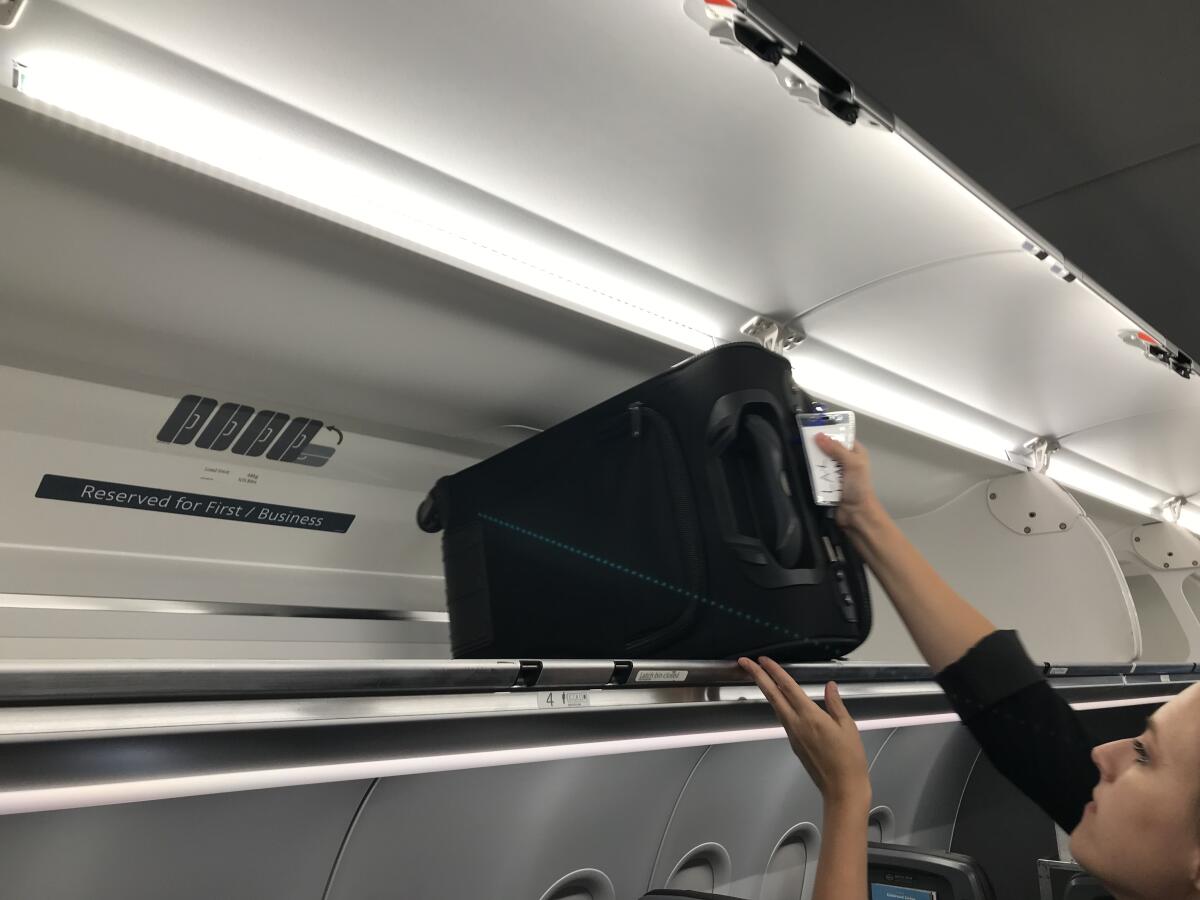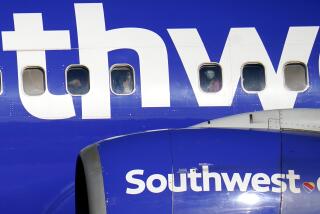Airlines supersize overhead bins -- but don’t want you to use them

Passengers who board American Airlines flights from Los Angeles to Orlando may notice that the overhead bins on the new Airbus A321 Neo planes have more luggage space — 40% more to be exact.
The world’s biggest carrier has added six of the new Airbus planes with plans for seven more by the end of the year, bringing a total of 70 Neo planes into the fleet over the next several years. Other airlines, including Delta and Alaska, are also adding Airbus and Boeing aircraft that come with larger overhead compartments.
Airlines are promoting the bigger bins as an effort to ease the frustration of passengers who can’t find space to stow their carry-on luggage. But that doesn’t mean they’re going to let passengers stuff the roomier bins with more or bigger bags: None plan to ease carry-on bag restrictions, and Alaska Airlines last year reduced the maximum size of carry-on luggage by 32%.
Instead, travel experts say, carriers are addressing a problem they created over the last decade by charging to check luggage and cramming more seats into each cabin to boost profits. The luggage fees prompted fliers to pack more into carry-on bags to avoid checking suitcases; the extra seats mean additional passengers and, thus, more carry-on bags.
“It’s a self-inflicted wound that the airlines have brought on themselves,” said Henry Harteveldt, a travel industry analyst with Atmosphere Research Group.
The move to larger overhead compartments comes after years of experimentation with a long list of new ways to increase revenue — such as charging for early boarding, extra leg room and other previously free amenities — so that airlines could remain profitable amid economic downturns, fierce competition, rising wages and fluctuating fuel costs.
The bigger bins also could be money makers for airlines because passengers are less likely to clog plane aisles while stowing and retrieving carry-on bags, which leads to costly delays. And the megabins create additional real estate that airlines can, in effect, rent out by enticing fliers to pay for early boarding to ensure their bags get into a nearby overhead.
The increasing shortage of overhead bin space has stressed passengers, flight attendants say, and has figured in on-board brawls.
In March 2018, a Southwest Airlines flight from Dallas to Los Angeles was delayed and all the passengers forced to exit after a fistfight broke out in a dispute over an overhead compartment, according to news reports and a video posted on social media.
“Passengers don’t like people touching their belongings and sometimes they get a little testy,” said Lori Bassani, president of the Assn. of Professional Flight Attendants, which represents American Airlines’ flight attendants. “The experience of flying has become stressful and touchy.”
“I do think the airlines created a lot of the problems” by charging to check luggage and adding seats to planes, Bassani said.
United Airlines said it has begun installing larger bins on some existing 737 planes and is taking delivery of new 737 aircraft with bins that can hold up to 62 additional bags on each plane.
United rations its bin space by forbidding passengers who buy the cheapest fare — basic economy — to put luggage in the overhead bin. Any basic economy passenger who brings a bag that doesn’t fit under the seat is charged to check the bag into the cargo hold.
Christina Boston, a real estate broker from Houston, complained that she paid more than $300 for a basic economy fare for her son to fly from El Paso to Houston last month.
“The airlines need to quit being so greedy,” she said. “How does it possibly cost them more for you to utilize your overhead space?”
Airlines shrug off the contention that they created the problem of insufficient overhead luggage space, saying the new planes now offer more than enough space for all the carry-on bags.
The bigger bins are good news for airlines because they eliminate the flight delays that come when fliers are unable to find space for their carry-on luggage and are forced to check the bags into the cargo hold.
“The faster they can get people seated and close the door, the better,” said Madhu Unnikrishnan, editor of the publication Skift Airline Weekly.
A takeoff delay on one flight can disrupt an entire day’s schedule of takeoffs and landings, costing an airline overtime pay for workers and compensation costs for passengers whose flights have been delayed.
Boeing Co. and Airbus, the world’s biggest aircraft manufacturers, design the planes, but the airlines make the final choices for the interior layout of each model, either by accepting a design offered by the manufacturers or choosing a third-party interior aircraft designer that can customize the seats, bathrooms and overhead bins for each model.
The bins on the A321 Neo can fit 40% more luggage because they are built with a thinner, lighter material, along with a door that flips up instead of having the entire luggage compartment pivot down to let passengers load bags. The bins are two inches deeper and two inches taller, allowing fliers to line up bags on their sides rather than load them flat.
“Customers will have an easier time finding space for their carry-on bag, helping expedite the boarding process,” said Kelsey Gion, a spokeswoman for American Airlines. “The Neo is a win-win for both our team members and our customers.”
Alaska Airlines operates eight A321 Neo planes with the larger bins but also flies 79 Boeing 737-900 ERs, which include a different overhead compartment design that can hold up to 48% more luggage. The bins on Alaska Airlines 737-900 ER are deeper and hang about two inches lower, which the carrier says make it easier for fliers to load heavy carry-on bags.
“The big push was because a vast majority of fliers expressed that their biggest anxiety was the fear that they couldn’t get space for their carry-on bags close to them,” Alaska Airlines spokeswoman Bobbie Egan said.
The carrier benefits from the bigger bins by eliminating delays in loading passengers, Egan said.
“Yes, we want to make sure everyone can load their carry-on bag in a bin and speed up the loading process,” she said.
The Seattle-based carrier began installing the larger bins over the past few years but despite the larger luggage space, Alaska Airlines announced last year that it was shrinking the maximum size of carry-on bags to bring the carrier in line with the size limits of competing airlines.
Delta Air Lines has ordered 100 A321 Neo planes containing larger overhead bins, with delivery expected to begin next year. In addition, the Atlanta-based carrier ordered 90 A220 planes that are advertised as having “high capacity overhead bins.” The carrier began accepting the new A220 planes last year and expects all 90 to be delivered by 2023.
“On medium and long-haul domestic flights, chances are very good that customers will be on an aircraft with larger overhead bins and thus less likely to have a carry-on bag checked at the gate,” Delta spokeswoman Liz Savadelis said.
More to Read
Inside the business of entertainment
The Wide Shot brings you news, analysis and insights on everything from streaming wars to production — and what it all means for the future.
You may occasionally receive promotional content from the Los Angeles Times.











